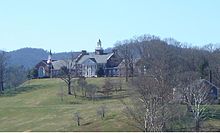Rabun Gap-Nacoochee School
| Rabun Gap-Nacoochee School Rabun Gap |
|
|---|---|
 |
|
| Address | |
|
339 Nacoochee Dr. Rabun Gap, GA United States |
|
| Information | |
| Type | private co-educational |
| Motto | Work, Study, Worship |
| Established | 1903 |
| Founder | Andrew Jackson Ritchie |
| Headmaster | Anthony Sgro |
| Chaplain | Reverend Jeffrey Reynolds |
| Grades | 5th-12th |
| Colour(s) | Green White and Gold |
| Mascot | Eagles (formerly Indians) |
| Newspaper | Mirror Images |
| Yearbook | Principium |
| Affiliation | Presbyterian Church |
| Website | www.rabungap.org |
Rabun Gap–Nacoochee School (informally known as Rabun Gap) is a small, private college preparatory school located in Rabun County, Georgia in the Appalachian Mountains. It is both a boarding and a day school. Rabun Gap is notable for initiating the Foxfire magazine project in 1966, experiential education based on interviewing local people, and writing and publishing articles about their stories and oral traditions. This inspired numerous schools across the country to develop similar programs. In addition to its strong academic program, today it is one of the few schools in the country to include a cirque skills program in its curriculum. The students put on an annual performance.
Rabun Gap-Nacoochee School is one of the largest coeducational, college-preparatory boarding schools in the South, serving boarding and day students in grades 5-12. Located in Rabun Gap, the 1,400-acre (5.7 km2) campus is cradled in the mountains of northeast Georgia. The school combines a strong academic program, mountain setting, and Presbyterian heritage to nurture and challenge students of diverse backgrounds as they prepare for college and a lifetime of service.
Andrew Jackson Ritchie, a Rabun County native, and his wife, Addie Corn Ritchie, founded the Rabun Gap Industrial School in 1903 to serve the children of the isolated and poverty-stricken community Rabun Gap. With $1 and a personal note, Ritchie bought a 5-acre (20,000 m2) hilltop for the school. Construction began on the two-story main building, designed by Atlanta architect Haralson Bleckley (son of Rabun County native Logan Bleckley), with pledges of cash support and manual labor. The school was open to both boys and girls.
Donations to the school declined during the World War I (1917–18) period, but Ritchie traveled to Boston, Massachusetts, and New York City to solicit funding. He had a unique plan for expansion and development called the Farm Family Settlement Program. Whole families would live at Rabun Gap, with the men learning agriculture, the women studying homemaking and health care, and the children continuing with regular studies. The Carnegie Foundation, the John D. Rockefeller family, and other northern philanthropists provided generous support for his idea. However, it was Ernest Woodruff, of the Coca-Cola Company and Trust Company of Georgia, who proved to be the bedrock supporter of Rabun Gap. According to school legend, Ritchie went door to door in Atlanta's Inman Park neighborhood asking for donations; at the Woodruff home, Emily Winship, Woodruff's wife, contributed money from her household fund and urged her husband to help. (Over time, several members of the Woodruff family, as well as the Robert W. Woodruff Foundation, have made donations to the school.) With additional support from the United Daughters of the Confederacy, the school expanded with more acreage and the construction of farmhouses and barns. The farm family program remained successful until the 1970s, when textile manufacturing became key in Rabun County.
...
Wikipedia
